#epdmpondliner
Explore tagged Tumblr posts
Text
EPDM Liners: A Reliable Solution for Your Pond
When it comes to creating a beautiful and functional pond, choosing the right liner is essential. EPDM (Ethylene Propylene Diene Monomer) liners are among the most popular options for pond enthusiasts. Known for their durability, flexibility, and ease of use, these liners can help you maintain a healthy and aesthetically pleasing water feature for years. Let’s dive into the world of EPDM liners and explore their benefits, applications, and maintenance tips.
What Are EPDM Liners?
EPDM liners are made from a synthetic rubber material that is highly resistant to UV rays, weathering, and chemicals. They are specifically designed for use in ponds, fountains, and other water features. Their flexibility and durability make them an ideal choice for projects of all sizes, from small backyard ponds to large commercial water systems.
Why Choose EPDM Liners?
Here are some key reasons why EPDM liners are a preferred choice:
Durability: EPDM liners are incredibly tough and can withstand harsh environmental conditions, including extreme temperatures, heavy rainfall, and prolonged exposure to sunlight.
Flexibility: These liners are highly flexible, making them easy to install in ponds of various shapes and sizes.
Environmentally Friendly: EPDM is a safe material that does not harm aquatic life, making it suitable for fish and plant habitats.
Long Lifespan: With proper care, EPDM liners can last 20 years or more, offering excellent value for your investment.
Ease of Maintenance: Minor damage can be repaired using patching techniques, ensuring your liner remains functional for years.
Common Uses of EPDM Liners
EPDM liners are versatile and can be used in various applications, including:
Backyard Ponds: Ideal for creating ornamental ponds in residential areas.
Koi Ponds: Their fish-safe properties make them suitable for koi and other aquatic creatures.
Waterfalls and Fountains: EPDM liners provide a waterproof base for decorative water features.
Retention Ponds: Used in landscaping projects to manage rainwater runoff.

How to Install an EPDM Liner
Installing an EPDM liner is a straightforward process that can be completed with basic tools and materials. Here are the steps:
Prepare the Site: Clear the area of debris, roots, and sharp objects that could puncture the liner.
Excavate the Pond: Dig the pond to the desired depth and shape. Include shelves for plants if needed.
Add a Protective Layer: Lay down a layer of geotextile fabric or sand to protect the liner from damage.
Place the EPDM Liner: Unroll the liner and position it over the pond. Smooth out wrinkles and folds.
Secure the Edges: Anchor the liner edges with rocks, soil, or other heavy materials.
Fill the Pond: Slowly fill the pond with water, adjusting the liner as needed to maintain a snug fit.
Maintaining EPDM Liners
Proper maintenance is crucial to prolong the life of your EPDM liner. Here are some tips:
Regular Inspections: Check for signs of wear, such as tears or holes, and address them promptly.
Clean Debris: Remove leaves, twigs, and other debris that can accumulate in the pond.
Fix Pond Liner Issues Quickly: If you notice leaks or damage, use a reliable patching method to restore the liner.
How to Fix Pond Liners
Over time, even the most durable pond liners may develop small leaks or tears. Fortunately, fix pond liner is easy with the right tools and materials. Here’s how you can repair your liner:
Locate the Damage: Drain the pond until the damaged area is exposed. Clean and dry the area around the tear.
Prepare the Patch: Cut a piece of patching material slightly larger than the damaged area.
Apply the Adhesive: Use a pond-safe adhesive to coat the damaged area and the patch.
Seal the Patch: Press the patch firmly onto the liner and smooth out any air bubbles.
Let It Cure: Allow the adhesive to cure for the recommended time before refilling the pond.
Choosing the Right Pond Liner Material
Selecting the best pond liner material depends on several factors, including the size and shape of your pond, budget, and intended use. EPDM liners are often the top choice due to their flexibility, durability, and ease of maintenance. Compared to other materials like PVC or polyethylene, EPDM liners offer superior performance and longevity.
If you’re unsure about the best material for your project, consult experts or visit PondPro2000 for professional advice.
Patching Pond Liners: Tips for Success
If you’re dealing with minor damage, patching pond liners is an effective way to extend their lifespan. Here are some additional tips for successful patching:
Use Compatible Materials: Ensure the patching material is compatible with your EPDM liner.
Clean Thoroughly: Dirt and debris can weaken the adhesive bond, so clean the area thoroughly before applying the patch.
Apply Pressure: Use a roller or similar tool to press the patch firmly onto the liner.
Monitor Repairs: Regularly check the patched area to ensure it remains secure over time.
Conclusion
EPDM liners are a durable, flexible, and environmentally friendly solution for ponds and water features. Whether you’re building a backyard pond or maintaining an existing one, investing in a high-quality EPDM liner ensures your water feature remains functional and beautiful for years to come.
0 notes
Text
What is the best product to seal a leaking pond?
Sealing a leaking fish pond is important to maintain the water level and protect the fish and other aquatic life. Here are some steps to seal a leaking fish pond:
Identify the source of the leak: The first step is to locate the source of the leak. This can be done by visually inspecting the pond for any visible signs of damage or leakage, such as cracks, tears, or holes in the pond liner. You can also use a dye or food coloring to help trace the source of the leak.
Drain the pond: Once you have identified the source of the leak, you will need to drain the pond to access the area that needs to be repaired. Use a pump to remove the water from the pond.
Clean the pond: Before applying any sealant, it is important to thoroughly clean the pond. Use a pressure washer or a stiff-bristled brush to remove any debris, algae, or sediment from the pond surface.
Patch the leak: If the leak is small, you may be able to patch it with a pond liner repair kit. These kits typically include patch material and adhesive that can be used to repair small holes or tears in the pond liner.

Use a sealant: There are several types of sealants that can be used to seal a leaking fish pond but Pond Pro 2000 is the best fish pond sealant. This can be applied directly to the surface of the pond liner to seal any leaks. Make sure to use a sealant that is safe for fish and aquatic life and follow the Pond Pro 2000 instructions manual for application and curing time.
Install a new pond liner: If the leak is too large or the pond liner is damaged beyond repair, you may need to install a new pond liner. There are several types of pond liners available, such as EPDM rubber, PVC, or polyethylene. The type of liner you choose will depend on your budget and the specific requirements of your fish pond.
Refill the pond: Once the leaking with sealant has cured or the new liner has been installed, you can refill the pond with water. Make sure to dichloride Nate the water before adding fish or aquatic plants back into the pond.
Before attempting to seal a leaking fish pond, it is important to identify the source of the leak and address any underlying issues. Additionally, it is important to follow the manufacturer's instructions for any sealants or pond liner materials that you use to ensure that they are applied correctly and will provide a long-lasting seal. Regular maintenance and inspection of the pond can also help to identify any potential issues before they become major problems.
youtube
1 note
·
View note
Text
All About Pond Liners: The Key to a Healthy Pond
Creating a pond in your garden or backyard can bring a touch of nature to your living space, providing a serene spot for relaxation and a habitat for various aquatic plants and animals. One crucial element of any pond is the pond liner. In this article, we will explore what a pond liner is, the different types of pond liner materials, how to install a pond liner, and answer some common FAQs about pond liners.
What is a Pond Liner?
A pond liner is a material used to line the bottom and sides of a pond to retain water and create a stable environment for aquatic life. It prevents water from seeping into the ground and helps maintain the water level in your pond. Pond liners come in various materials, each with its own advantages and disadvantages.
Types of Pond Liner Materials
Choosing the right pond liner material is crucial for the longevity and effectiveness of your pond. Here are some common types:
Rubber Liners
Rubber liners are popular due to their flexibility and durability. They can withstand extreme temperatures and UV radiation, making them ideal for outdoor ponds. EPDM (Ethylene Propylene Diene Monomer) is a common type of rubber liner known for its resistance to weathering and tearing.
PVC Liners
PVC (Polyvinyl Chloride) liners are another common choice. They are more affordable than rubber liners but are not as durable. PVC liners are best suited for smaller ponds or temporary installations.
Liquid EPDM Pond Liners
A liquid EPDM pond liner is a versatile option that can be applied to various surfaces, including concrete, metal, and wood. It creates a seamless, waterproof barrier that is highly durable and resistant to UV rays. Liquid EPDM is easy to apply and can be used to repair existing liners.

Installing a Pond Liner
Installing a pond liner involves several steps to ensure a proper fit and a long-lasting pond. Here’s a simple guide:
Plan and Prepare
Design your pond: Decide on the shape, size, and depth of your pond.
Clear the area: Remove any sharp objects, roots, or debris that could puncture the liner.
Excavate the pond: Dig out the pond area according to your design.
Add Underlayment
Underlayment is a protective layer placed beneath the pond liner to prevent punctures and provide cushioning. You can use commercial underlayment or materials like old carpeting or sand.
Install the Pond Liner
Position the liner: Lay the liner over the excavated area, leaving enough material to extend beyond the pond edges.
Smooth out wrinkles: Carefully adjust the liner to eliminate wrinkles and ensure a snug fit.
Anchor the edges: Use rocks, bricks, or soil to secure the liner edges around the pond perimeter.
Fill and Finish
Fill the pond with water: Gradually fill the pond with water, smoothing out any remaining wrinkles as it fills.
Trim excess liner: Once the pond is filled, trim any excess liner, leaving a few inches beyond the pond edge.
Add landscaping: Finish your pond with rocks, plants, and other decorative elements.
Patching Pond Liners
Over time, pond liners may develop leaks or tears. Patching pond liner is a straightforward process that can extend the life of your liner. Here’s how to do it:
Locate the Leak
Inspect the liner: Carefully examine the liner for visible tears or holes.
Mark the spot: Use a marker to highlight the damaged area.
Prepare the Patch
Clean the area: Clean the area around the leak with a cloth and a mild detergent.
Cut the patch: Cut a piece of liner material slightly larger than the damaged area.
Apply the Patch
Apply adhesive: Use a suitable adhesive for your liner material to apply the patch.
Press firmly: Press the patch onto the damaged area, ensuring a tight seal.
Allow to cure: Let the adhesive cure according to the manufacturer’s instructions before refilling the pond.
Conclusion
Choosing the right pond liner is essential for maintaining a healthy and beautiful pond. Whether you opt for a traditional rubber liner or the versatility of a liquid EPDM pond liner, proper installation and maintenance will ensure your pond remains a tranquil haven for years to come. With this guide, you're well-equipped to make informed decisions about your pond liner and enjoy the benefits of a thriving aquatic environment.
0 notes
Text
Mastering Pond Maintenance: A Comprehensive Guide to Fixing Pond Liners
Are you grappling with pond liner issues? Don't let leaks and tears dampen your pond experience. Whether you're a seasoned pond enthusiast or just starting out, understanding how to fix pond liners is crucial for maintaining a healthy and vibrant aquatic ecosystem. In this guide, we'll delve into the nitty-gritty of pond liner repair, ensuring your water feature remains a source of joy and tranquility.
Identifying the Problem:
Before diving into repairs, it's essential to diagnose the issue accurately. Common problems include leaks, tears, and deterioration. Keep an eye out for water loss, unusual wrinkles, or visible damage to the pond liner. Once you've pinpointed the problem areas, it's time to take action.
Choosing the Right Materials:
For durable and long-lasting repairs, opt for high-quality materials like EPDM pond liner patches or coatings. EPDM (ethylene propylene diene monomer) pond liners are renowned for their resilience and flexibility, making them ideal for various pond sizes and shapes. Investing in the best pond liner materials ensures a robust and reliable fix, giving you peace of mind for years to come.
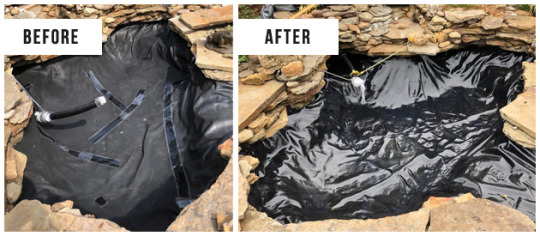
Repairing Leaks and Tears:
Clean and Dry: Start by draining the pond and thoroughly cleaning the affected area. Remove any debris or algae that may impede the repair process. Ensure the surface is dry before proceeding.
Patching: Apply an EPDM pond liner patch over the tear or leak, ensuring a tight seal. Press down firmly to eliminate air bubbles and promote adhesion. For larger tears, consider using a patch larger than the damaged area for added reinforcement.
Sealing: To prevent future leaks, apply a fish pond coating over the patched area. This additional layer adds an extra barrier against water infiltration and enhances the longevity of the repair.
Preventive Maintenance Tips:
Regular Inspections: Schedule routine inspections of your pond to catch any potential issues early on. Look for signs of wear and tear, especially in high-traffic areas or around protruding objects.
Protective Measures: Minimize the risk of damage by installing protective measures such as pond underlayment or padding beneath rocks and decorations.
Water Quality Management: Maintain optimal water quality to reduce the likelihood of liner degradation. Proper filtration, aeration, and regular water testing are essential for a healthy pond environment.
Conclusion:
With the right knowledge and materials, fix pond liners can be a straightforward task. By investing in quality products like EPDM pond liners and coatings, you'll ensure a durable and reliable repair that stands the test of time. Remember to conduct regular inspections and practice preventive maintenance to keep your pond in pristine condition. With these tips in hand, you'll be well-equipped to tackle any pond liner challenges that come your way.
0 notes
Text
The Ultimate Guide to Fixing Pond Liner Leaks with EPDM Material
Are you tired of dealing with pesky leaks in your pond? Don't worry, we've got the perfect solution for you! In this comprehensive guide, we'll walk you through the simple steps to fix pond liner issues using high-quality EPDM pond liner material.
Understanding the Problem:
Leaky ponds can lead to a host of problems, from water loss to potential damage to your garden or landscape. The key to solving these issues lies in a well-maintained pond liner. If you're noticing leaks or wear and tear, it's time to take action.
Choosing the Right Material:
EPDM (Ethylene Propylene Diene Monomer) pond liner material is your go-to solution. Known for its durability and flexibility, EPDM is a synthetic rubber that can withstand the harsh elements and provide a long-lasting solution to your pond liner problems.
Step-by-Step Guide to Fix Pond Liner:
Identify the Leak:
Start by locating the source of the leak in your pond. Look for any visible tears, punctures, or weak points in the liner.
Clean and Prepare:
Before applying the EPDM pond liner material, ensure that the affected area is clean and free of debris. A thorough cleaning will enhance the bonding process.
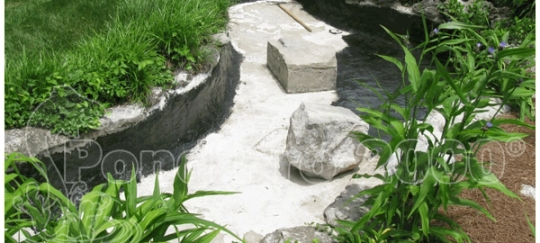
Apply EPDM Pond Liner Material:
Cut the EPDM material to cover the damaged area with a generous overlap. Apply an adhesive designed for EPDM bonding and press the material firmly onto the affected section.
Seal and Cure:
After applying the EPDM pond liner material, ensure a proper seal by pressing down and smoothing out any air bubbles. Allow the adhesive to cure according to the manufacturer's instructions.
Inspect and Fill:
Once the repair is complete, inspect the entire pond liner for any additional issues. Once satisfied, refill your pond and monitor for any further leaks.
Conclusion:
With this easy-to-follow guide, you can bid farewell to those frustrating pond leaks. By utilizing the power of EPDM pond liner material, you're not just fixing the problem; you're ensuring the longevity of your pond. Follow these steps, and you'll have a watertight pond ready to enhance the beauty of your landscape. Happy pond-keeping!
0 notes
Text
Unveiling the Magic of EPDM Liners for Pond Perfection
If you're a pond enthusiast, you're likely familiar with the importance of a reliable liner to ensure the longevity and health of your aquatic haven. In the realm of pond liners, one material stands out – EPDM liners. Let's dive into the world of EPDM liners and discover why they are the go-to choice for pond enthusiasts.
Understanding EPDM Liners
EPDM liners have gained immense popularity in the world of pond construction and maintenance. Their composition of synthetic rubber, derived from ethylene and propylene, grants them unique properties that make them ideal for various applications, including pond construction.
Durability Beyond Compare
One of the primary reasons EPDM Pond liners are preferred is their exceptional durability. These liners can withstand harsh weather conditions, UV rays, and temperature fluctuations without losing their structural integrity. This resilience ensures that your pond remains leak-free and resistant to wear and tear, providing a long-lasting solution for your aquatic oasis.
Repair Pond Liners with Ease
EPDM liners offer a convenient solution for pond enthusiasts facing liner damage. If you encounter issues such as punctures or tears, worry not – repairing EPDM liners is a straightforward process. Specialized repair kits are available, containing everything you need to repair pond liners efficiently. Whether it's a minor puncture or a more significant tear, EPDM liners make the repair process hassle-free.
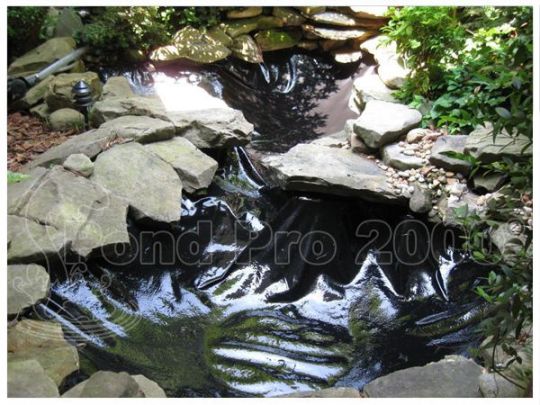
The Fix Pond Liner Advantage
EPDM liners not only excel in durability but also in flexibility. Their pliability allows for easy installation, conforming to the contours of your pond with minimal effort. This flexibility extends to repairs as well. When you need to fix pond liner, EPDM's malleability ensures a seamless patching process, maintaining the structural integrity of your pond.
Choosing the Right Pond Liner Material
When selecting a pond liner material, it's crucial to consider factors such as durability, flexibility, and ease of repair. EPDM liners check all these boxes, making them an excellent choice for pond enthusiasts. Their proven track record in pond construction and maintenance speaks volumes about their reliability and effectiveness.
Conclusion
In conclusion, if you're aiming for a pond that stands the test of time, investing in an EPDM liner is a wise choice. From withstanding the elements to providing easy solutions for repair, these liners ensure that your pond remains a thriving ecosystem for years to come.
0 notes
Text
Choosing the Right Pond Liner Material: A Guide to EPDM Pond Liners and Coatings
When it comes to creating a thriving and long-lasting pond, the choice of pond liner material is crucial. In this guide, we'll explore the ins and outs of pond liners, with a focus on two key aspects: EPDM pond liners and pond coatings.
Understanding Pond Liners:
Pond liners serve as the foundation for your aquatic haven, preventing leaks and providing a secure environment for aquatic life. Among the various materials available, EPDM (Ethylene Propylene Diene Monomer) stands out for its durability, flexibility, and suitability for various pond designs.
EPDM Pond Liners:
EPDM pond liners are a popular choice for both amateur pond enthusiasts and professional landscapers. Their high flexibility allows for easy installation in ponds of different shapes and sizes. EPDM is also known for its resistance to UV rays and temperature extremes, ensuring longevity even in challenging weather conditions.
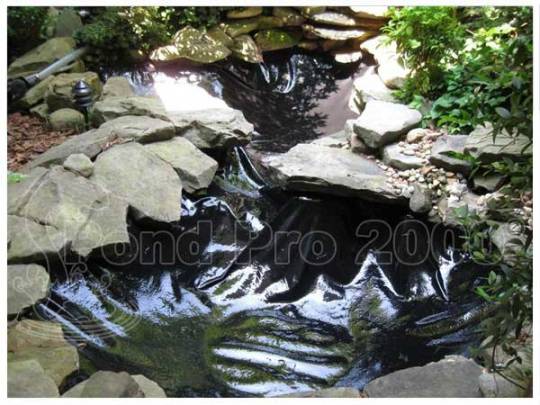
Pond Coatings for Added Protection:
To enhance the performance and lifespan of your pond liner, consider applying specialized pond coatings. These coatings act as an additional layer of protection, guarding against punctures, UV damage, and potential wear and tear over time. When choosing pond coatings, ensure compatibility with your selected liner material for optimal results.
Factors to Consider:
Pond Size and Design:
Tailor your choice of pond liner material to fit the specific design and size of your pond.
Climate Considerations:
EPDM pond liners are known for their ability to withstand various climates, making them suitable for both hot and cold regions.
Installation Tips:
Seek professional advice or follow manufacturer guidelines for proper installation, ensuring a watertight seal.
Conclusion:
Investing in the right pond liner material is fundamental to the success of your aquatic project. Whether you opt for the flexibility of EPDM pond liners or enhance protection with specialized coatings, a well-thought-out choice will contribute to the longevity and beauty of your pond.
0 notes
Text
Choosing the Right Pond Liner for a Leaks-free Water Paradise
Have you at any point longed for having a tranquil and beautiful fish pond in your terrace? A very much kept up with pond can be a lovely expansion to your outside space, offering peacefulness and a dash of nature to your home. Nonetheless, one of the fundamental parts of a solid pond is the pond liner. We'll dive deep into the world of pond liners, focusing on fish pond coating, fix pond liners, and exploring the benefits of EPDM pond liners.
Fish Pond Coating: Ensuring a Durable Foundation:
Fish pond coating is the first line of defense against leaks and water seepage. The right coating can make a significant difference in the longevity and performance of your pond. When choosing a coating, consider factors like durability, flexibility, and resistance to UV rays. EPDM (ethylene propylene dyne terpolymer) pond liners are an excellent choice for fish ponds due to their outstanding durability and resistance to weathering.
Fixing Pond Liners: Addressing Common Issues:
Over time, pond liners can develop wear and tear, leading to leaks and water loss. It's essential to address these issues promptly to maintain a healthy pond environment. Common problems include punctures, tears, and wrinkles in the liner. To fix pond liners, start by identifying the source of the problem. Patching kits and sealants can be used for smaller issues, while larger tears may require liner replacement. Regular inspections and maintenance can prevent these problems from escalating.
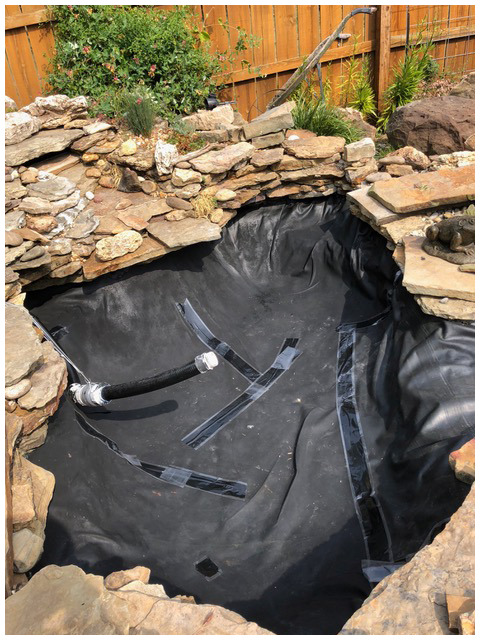
EPDM Pond Liners: A Premium Choice:
EPDM pond liners have gained popularity among pond enthusiasts for several reasons. They are known for their exceptional durability and resistance to UV radiation, making them an excellent choice for long-term pond projects. EPDM liners are also highly flexible, allowing for easy installation in various pond shapes and sizes. Their high elasticity prevents cracks and tears, providing peace of mind for pond owners.
Benefits of EPDM Pond Liners:
Durability: EPDM pond liners can last for decades, ensuring a low-maintenance pond experience.
UV Resistance: They can withstand prolonged exposure to sunlight without degrading.
Flexibility: EPDM liners can conform to the contours of your pond, reducing the risk of leaks.
Eco-Friendly: EPDM is an environmentally friendly material, safe for aquatic life.
Easy Installation: Their flexibility simplifies installation, even for complex pond designs.
Conclusion:
Investing in the right pond liner, such as EPDM, is crucial for maintaining a beautiful and leak-free pond. Fish pond coating and prompt attention to fixes are equally important to ensure your pond's longevity. With the proper care and choice of materials, your backyard water paradise can provide years of enjoyment and relaxation.
Remember to regularly inspect your pond liner, especially if you notice any issues, and consider using EPDM pond liners for a durable and eco-friendly pond solution. Enjoy your beautiful pond and the serenity it brings to your outdoor space.
youtube
1 note
·
View note
Text
Repairing Pond Leaks During Summer
Repairing pond leaks during the summer can be challenging, as the high temperatures and evaporation rates can make it difficult to keep water levels stable. Here are some tips for repairing pond leaks during the summer:
Identify the source of the leak: Before you can repair the leak, you need to know where it is located. Look for obvious signs of damage, such as cracks or punctures in the pond liner or visible leaks around the edges of the pond.
Determine the extent of the damage: Once you have identified the source of the leak, you need to assess the extent of the damage. If the leak is small, you may be able to repair it using a sealant or patch. If the damage is more extensive, you may need to replace the pond liner or make more significant repairs.
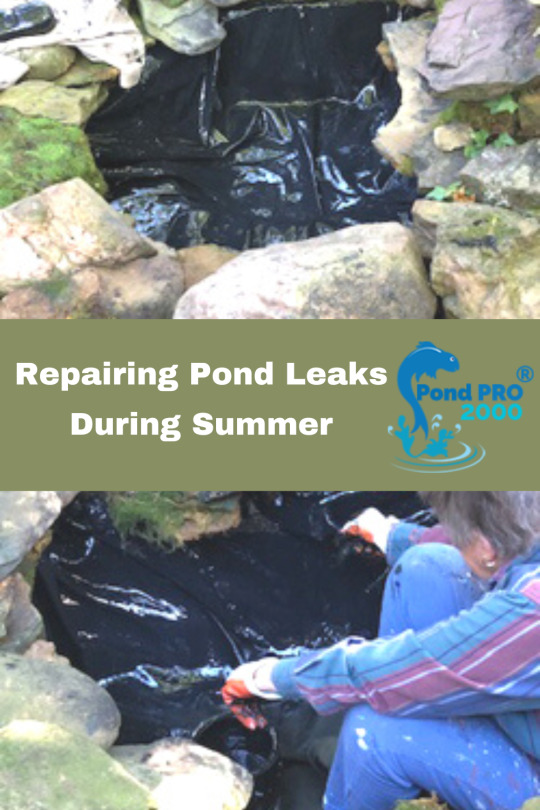
Lower the water level: To make repairs, you will need to lower the water level in the pond. However, in the summer, it's essential to keep the water level as stable as possible to prevent evaporation. Consider using a temporary water source, such as a garden hose, to keep the water level stable while you make repairs.
Use a compatible sealant: When repairing pond leaks, make sure to use a sealant that is compatible with your pond liner material. For example, if you have a rubber pond liner, choose a sealant that is specifically designed for rubber.
Follow the manufacturer's instructions: Always follow the manufacturer's instructions carefully when applying sealant or making repairs to your pond. Be sure to allow the sealant to dry completely before refilling the pond.
Overall, it's important to act quickly to repair pond leaks to prevent further damage to your pond and the surrounding ecosystem. By identifying the source of the leak, assessing the damage, and using a compatible sealant, you can successfully repair pond leaks during the summer.
youtube
0 notes
Text
Selecting the Best Pond Liner
There are several types of pond liners available on the market, and the best one for you will depend on your specific needs and requirements. Here are some of the most commonly used pond liner materials:
EPDM (Ethylene Propylene Diane Monomer): EPDM is a highly durable and flexible synthetic rubber that is commonly used for pond liners. It is resistant to UV rays, weathering, and tearing, making it a popular choice for both residential and commercial pond applications.
PVC (Polyvinyl Chloride): PVC is a popular choice for pond liners due to its affordability and ease of installation. It is a flexible, plastic material that is resistant to UV rays, punctures, and tears.
Polyethylene: Polyethylene is a lightweight and flexible material that is commonly used for small, shallow ponds. It is easy to install and is available in a variety of thicknesses.
Butyl Rubber: Butyl rubber is a highly durable and flexible material that is resistant to UV rays, weathering, and punctures. It is a popular choice for large, commercial ponds due to its strength and longevity.
When choosing a pond liner, it's important to consider factors such as durability, flexibility, and UV resistance. You should also choose a material that is suitable for the size and shape of your pond, as well as the types of plants and fish that will be living in the pond. Be sure to read the manufacturer's instructions carefully.
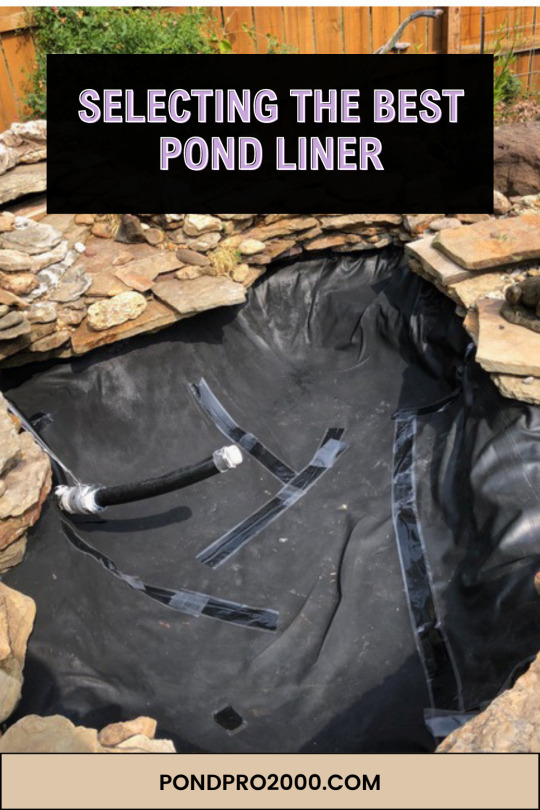
Why Pond Pro 2000?
Pond Pro 2000 has good customer reviews and success stories. Pond Pro 2000 is a liquid butyl rubber pond liner that is designed to provide a durable and long-lasting solution for pond repair and waterproofing. Here are some reasons why Pond Pro 2000 may be a good choice for your pond:
Durability: Pond Pro 2000 is made from a butyl rubber that is highly durable and resistant to UV rays, weathering, and punctures. It can withstand extreme temperatures and remains flexible even in cold weather, making it a good choice for ponds located in harsh climates.
Easy to apply: Pond Pro 2000 is a liquid liner that can be easily applied to any size or shape of pond using a brush or roller. It can also be sprayed on using a specialized sprayer. This makes it a convenient and cost-effective solution for pond repairs and waterproofing.
Versatile: Pond Pro 2000 can be used on a variety of surfaces, including concrete, wood, and metal. It is also safe for fish and plants, making it a good choice for ponds that contain aquatic life.
Long-lasting: Pond Pro 2000 is designed to provide long-lasting protection against leaks and other types of damage. It has a lifespan of up to 10-15 years, which makes it a cost-effective solution in the long run.
Warranty: Pond Pro 2000 comes with a 5-year manufacturer's warranty, which provides added peace of mind and protection against product defects.
Overall, Pond Pro 2000 is a high-quality, reliable and best pond liner that offers several advantages over other types of pond liners. If you are looking for a durable and long-lasting solution for your pond, Pond Pro 2000 may be a good choice for you.
youtube
0 notes
Text
The Essential Guide to Pond Liners: Fish Pond Coating, Patching Pond Liners, and EPDM Pond Liners
Pond liners are a critical component of any successful pond construction project. Whether you want to make a peaceful koi pond or an energetic water garden, grasping the subtleties of pond liners, for example, fish pond coating, patching pond liners, and EPDM pond liners, is fundamental for guaranteeing the life span and respectability of your sea-going shelter. We will dive into the universe of pond liners and investigate how these components assume a urgent part in your lake's wellbeing and usefulness.
The Significance of Picking the Right Lake Liner
When embarking on a pond project, the choice of pond liner is paramount. There are different choices accessible, however three stick out: fish pond coating, patching pond liners, and EPDM pond liners. How about we dive further into every one of these decisions to assist you with settling on an educated choice.
Fish Pond Coating - A Versatile Option
Fish pond coating, otherwise called Lake Sealant, is a flexible choice for pond development. It gives a tough, waterproof hindrance that keeps water from saturating the dirt. Fish pond coatings are particularly well known among Do-It-Yourself lake devotees because of their simplicity of use and reasonableness.
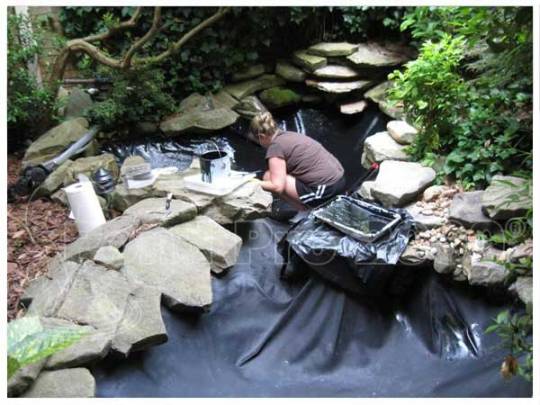
Patching Pond Liners - Repairing Your Investment
Over time, pond liners may develop leaks or tears, leading to water loss and potential damage to your pond ecosystem. That's where patching pond liners come into play. Learn how to identify and repair common liner issues, ensuring your pond remains watertight and thriving.
EPDM Pond Liners - The Gold Standard
EPDM (Ethylene Propylene Diene Monomer) pond liners have gained a reputation as the gold standard in pond liner technology. They are known for their exceptional durability, flexibility, and resistance to UV rays. Discover why many professional pond builders and enthusiasts prefer EPDM pond liners for their longevity and reliability.
Maintaining Your Pond Liner
Maintaining your pond liner is crucial for the health of your aquatic ecosystem. Learn best practices for cleaning, inspecting, and preserving your chosen liner type to ensure your pond remains a vibrant and thriving habitat.
Conclusion
Choosing the right pond liner is a critical step in creating and maintaining a healthy pond environment. Whether you opt for fish pond coating, need to patch an existing liner, or invest in the durability of EPDM pond liners, your choice will impact the success of your pond project. By understanding these options and optimizing your selection, you can create a beautiful and sustainable pond that will provide enjoyment for years to come.
youtube
0 notes